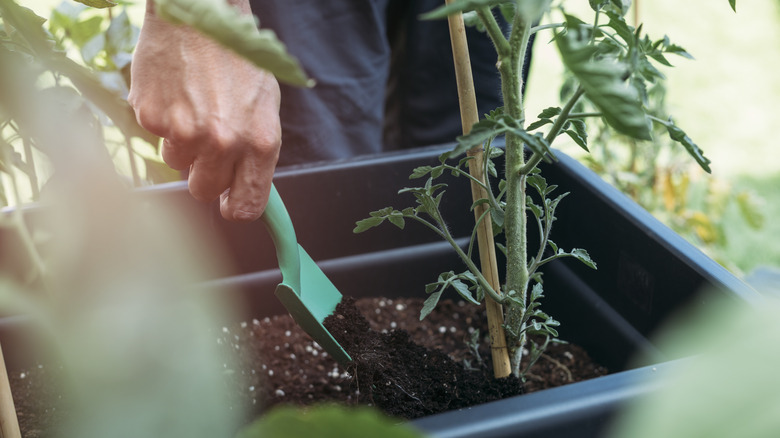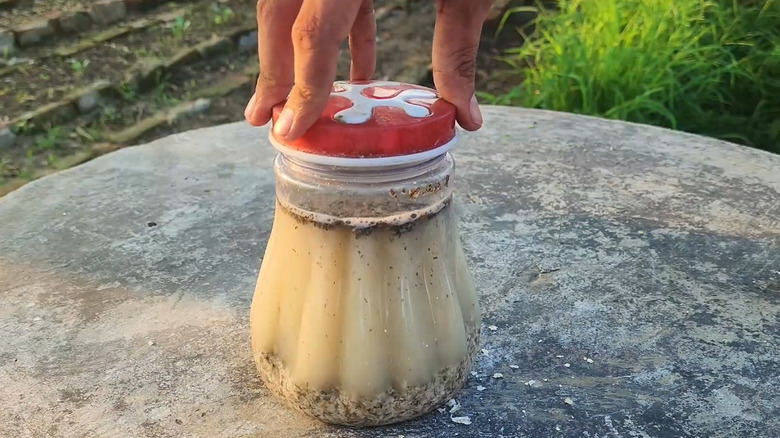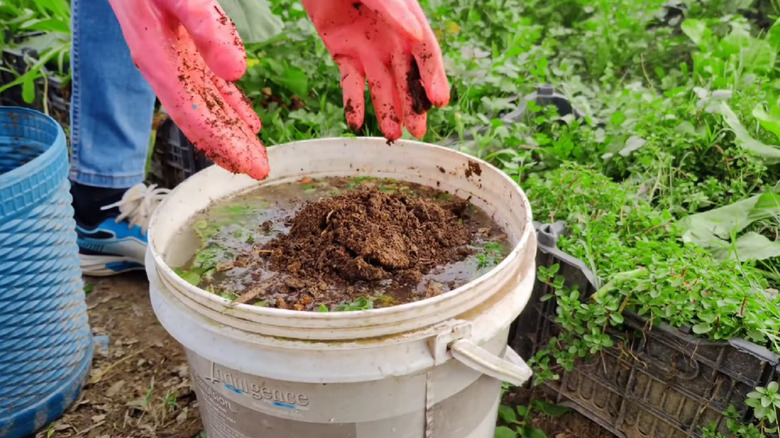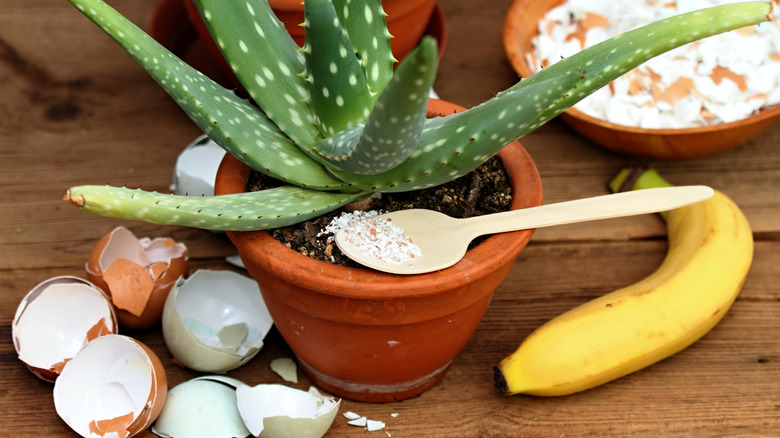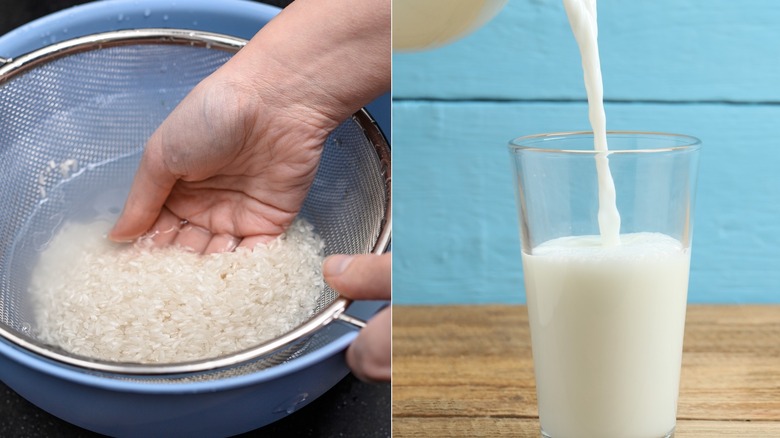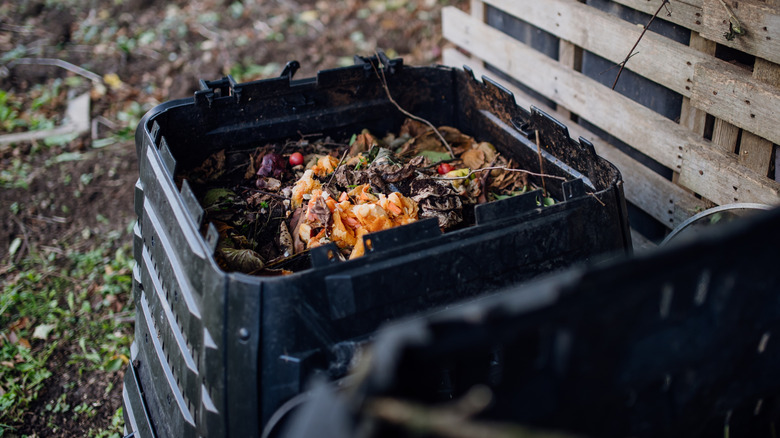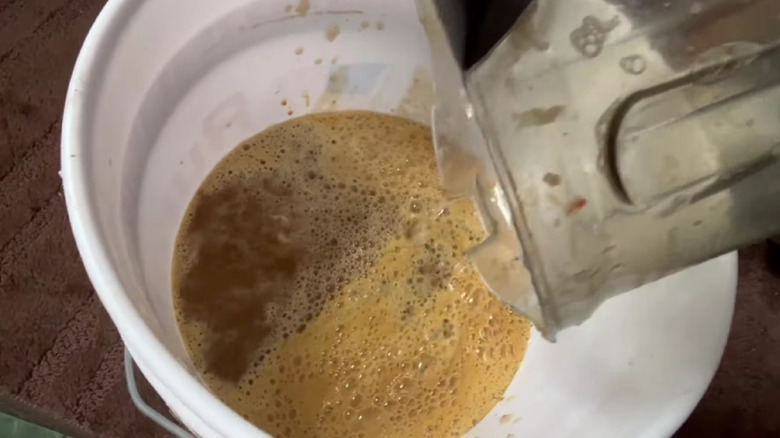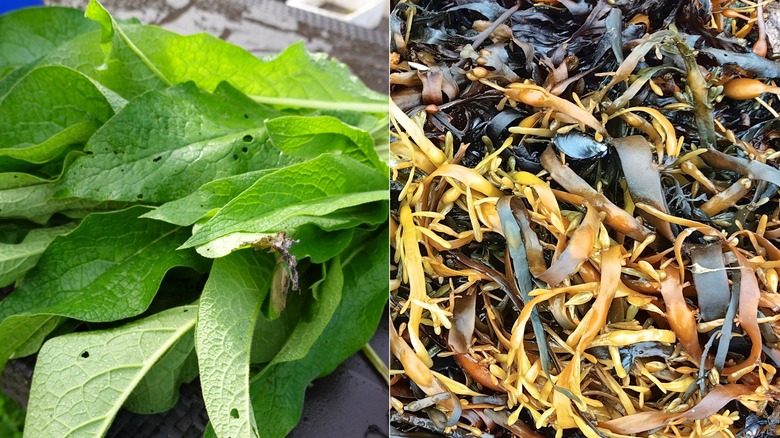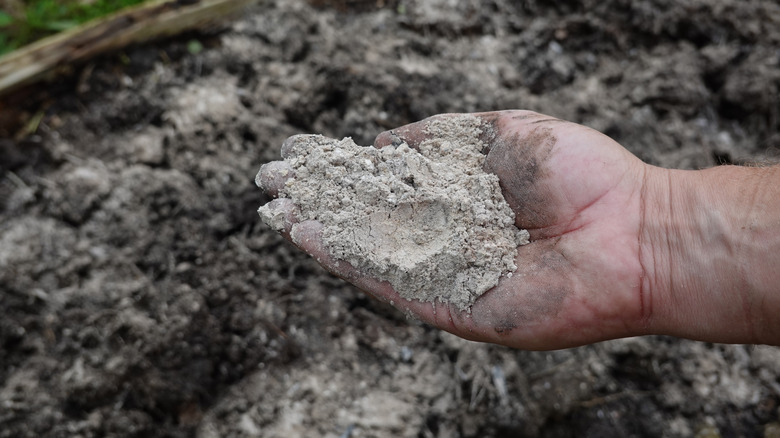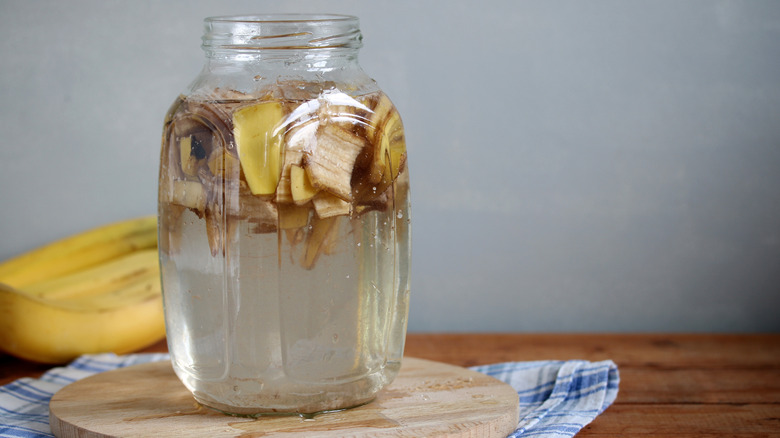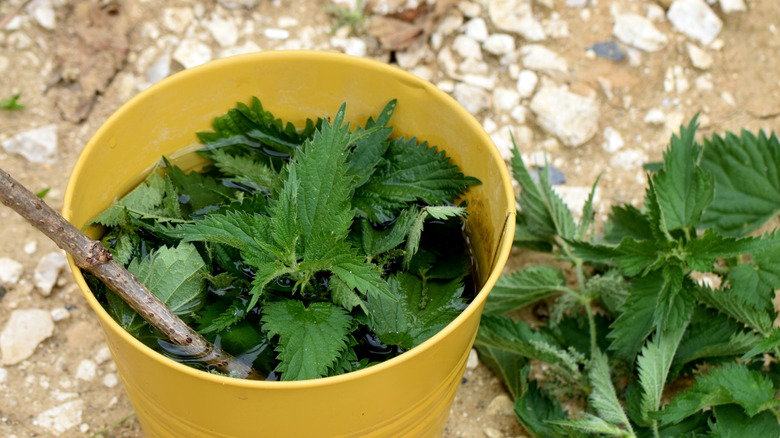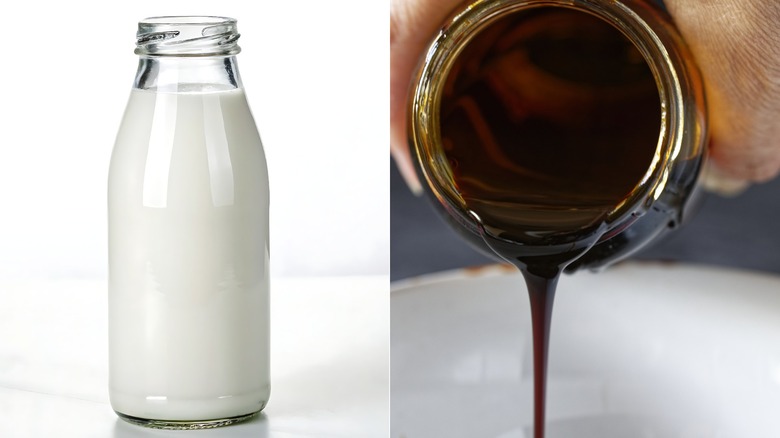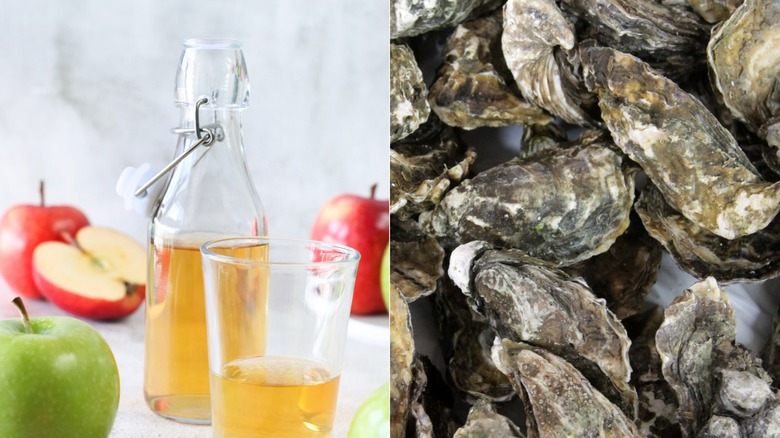Simple 2 Ingredient Fertilizers For Healthy Plants And Soil
While synthetic fertilizers are filled with complicated ingredients that most of us can't pronounce, said ingredients may not be as beneficial to the soil in our gardens as much as we'd like to think. While they do provide a quick boost to our plantings, in the long run soil health and environmental pollution could be a concern with continual use of these commercial fertilizers. That's not to say that all fertilizers are bad; in fact, there are ways to create simple, natural nutrients to apply to your veggies and flowers without compromising the health of the ecosystem. Many natural fertilizers only need one or two ingredients, proving how effective and powerful natural alternatives can be.
With these simple two-ingredient fertilizer solutions, you'll likely be able to reuse and repurpose household waste, an assortment of cooking byproducts, as well as common pantry staples to create either liquid or dry fertilizers to dole out to your garden and indoor plants. These duos, ranging from tea leaves and oats to fish emulsions (we'll explain) all provide nutrient-rich boosts to the soil as well as benefit root growth and production. And while many of these components fare well by themselves as fertilizers, these pairings are believed to amplify the best of each other, increasing all that good stuff for your plantings. Nutrients that plants thrive on, like magnesium, potassium, phosphate, and nitrogen, are abundantly present in these fertilizer recipes, so pick your [non] poison.
Tea & Oats
These two handy kitchen ingredients can help keep your garden fertile: tea leaves and oats. Tea is a great source of nitrogen for lush growth; meanwhile oats and oatmeal have a reputation for stimulating plants' root growth when added to soil. Combine the two ingredients together in water, let it soak for at least an hour, then strain the oats and tea out. Use the infused water to feed your plants some goodness, and watch them grow!
Potato plants & soil/compost
If you're a garden enthusiasts that grows veggies, namely potatoes, then this combo will work wonders to get your beds prepped for more crops. Once you've harvested your potatoes and have leftover plant clippings, stick those clippings in a large bucket of rain water (or other non-chlorinated water), then add handfuls of soil or compost. Put a lid on the bucket, let it sit for at least a week, and you'll have a nutrient-filled soup for your garden. Fair warning, this fertilizer idea can get stinky, so it's best to utilize outdoors rather than for indoor plants.
Banana peels & eggshells
These ingredients independently are already good for the soil. Bananas provide a rich source of potassium, nitrogen, and phosphorus for plants while egg shells contain ample amounts of calcium carbonate. Combined in a fertilizer tea, you'll get the best benefits of both resources. Place the skins and the shells in a large pot, and fill it with water so that both things are completely submerged. Let the combo steep for a few days, then remove the solid pieces and toss it in your compost. Use the leftover liquid with water to keep your plants thriving throughout the year.
Rice water & milk
Studies show that rice water alone is an effective fertilizer that encourages increased nutrient uptake by plants, but when fermented with milk, the combo has the potential to provide even more benefits to plants due to rich lactic acid production. First, let rice water age a few days, then when the time is right, add milk — 10 parts milk to one part rice water. Once mixed, let the mixture ferment for another few days, out of sunlight. While the end product may smell a little ripe, you can apply it to plants for better nutrient absorption.
Coffee grounds & brown material
Coffee grounds are celebrated as nitrogen-boosting ingredients in a compost pile. Its presence also help skill weed seeds and disease pathogens since coffee grounds maintain high composting temperatures, an essential quality to maintain the health of the soil it will go into. But as a "green waste" material, coffee grounds need to be composted with "brown material" — dried leaves, paper, yard clippings — for balance. Create a mixture of equal parts for composting, then use the nutrient-rich material as a boosting fertilizer for your garden soil.
Fish waste & brown waste
Speaking of brown waste, it's the key ingredient in this suggestion, but the other half of this recipe is a bit fishy. While you may think there wasn't another good use for fishy castoffs from cooking, combining it with brown waste creates another fertilizer soup that's delicious and nutritious for plants. Combine fish scraps with a layer of brown waste, like leaves, and cover the combo with water. Seal off the mixture, stirring it every once in a while. After a few weeks, strain the solids out of the solution and dilute it with water before applying to the garden.
Seaweed & comfrey
Here are two ingredients you may have never have thought you'd read about together, but combined they make for a mean fertilizer tea. Particularly if you live coastally where you can harvest seaweed easily, this pairing is the unexpected but unstoppable fertilizer force that'll help grow healthy and resilient plants. Seaweed is jam packed with nutrients, namely manganese, zinc, copper, potassium, iron, and iodine while comfrey (Symphytum officinale) is a key soil builder. Mix them together in a bucket filled with non-chlorinated water, and let it brew for a few months. Pour the resulting liquid onto compost for a great fertilizing boost.
Wood ash & compost or soil
Wood ash, as a stand alone additive to garden beds, is an incredibly beneficial soil amendment due to its high amounts of potassium and calcium. This makes it a fantastic lime-alternative, though should not be used for plants that enjoy soil pH levels that are higher, like blueberries. Despite its power as a solo player, when combined with either compost or moist soil, it creates a much easier-to-apply dry fertilizer that's far less messy to place in garden beds than wind-prone and dusty ash by itself.
Banana peels & vinegar
Returning to the nutrient-rich banana peel packed with all the goodies soil needs, another method to create peel tea is with vinegar. Vinegar is an acidic ingredient that helps break down the bananas faster to release its nutrients. While some question if banana peel and vinegar fertilizer is a powerful gardening tool, it is an incredibly beneficial additive. Although it won't suffice as your only fertilizer, it's loved by acidic soil plants, like roses and hydrangeas, making it the perfect little boost for those summertime sweethearts.
Nettles & comfrey
It's hard to see the benefits of weeds — they're a pain to deal with, and it can feel like they have no real value. But with a weed-based fertilizer tea, you'll be singing these plants' praises. Different weeds have different nutrient benefits, with plants like nettles (Urtica dioica) rich in nitrogen and comfrey rich in potassium. Combine the two together for a nutrient-packed fertilizer. Steep your tea as you would with other combinations on this list (remember, rain water or non-chlorinated water is key), then once ready, add to your watering can for best results.
Milk & Molasses
No this isn't the start of a cookie recipe, rather milk and molasses is a fertilizer trick used around the world as a natural, sustainable way to increase nutrients in the soil. The sugars from the molasses and the protein from the milk ferment together to create a solution rich in all the elements you'd want to feed to your plants. Mix 2 cups of milk, 8 cups of water, and 1/4 cup of molasses together, letting it brew for several weeks. Then apply a cup of the solution to plants once a week for beautiful growth.
Apple cider vinegar & oyster shells
This combination harnesses the minerals found in oyster shells (or other mollusks like clams, mussels, and scallops) with the decomposition power of apple cider vinegar to create a calcium, magnesium, and manganese-rich solution for your garden. First, cook the shells to remove any films or fats from the material, then let them cool. Like with other liquid fertilizer recipes on this list, submerge your spent oyster shells in a container, then fill with vinegar to just an inch below the top. Cover it and let it marinate for two weeks, before straining the shells out.
